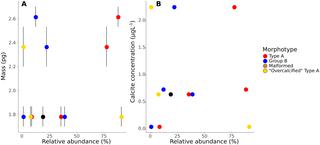PLOS ONE ( IF 3.7 ) Pub Date : 2020-03-27 , DOI: 10.1371/journal.pone.0230569 Simen Alexander Linge Johnsen 1 , Jörg Bollmann 1

|
Different morphotypes of the abundant marine calcifying algal species Emiliania huxleyi are commonly linked to various degrees of E. huxleyi calcification, but few studies have been done to validate this assumption. This study investigated therefore whether E. huxleyi morphotypes can be related to coccolithophore calcification and coccolith mass. Samples from January (high productivity) and September (low productivity) 1997 at an open ocean and a coastal site near the Canary Islands were analysed using a combination of thickness measurements (Circular Polarizer Retardation estimates (CPR) method), Scanning Electron Microscope imaging, and Markov Chain Monte Carlo (MCMC) models. Mean E. huxleyi coccolith mass varied from a maximum of 2.9pg at the open ocean station in January to a minimum of 1.7pg in September at both stations. In contrast, overall calcite produced by E. huxleyi (assuming 23 coccoliths/cell) varied from a maximum of 2.6 μgL-1 at the coastal station in January to a minimum of 0.5 μgL-1 in September at the open ocean site. The relative abundance of “Overcalcified” Type A, Type A, Group B and malformed coccoliths was determined from SEM images. The mean coccolith mass of “Overcalcified” Type A was 2.0pg using the CPR-method, while mean mass of Type A and Group B coccoliths was determined using coccolith length measurements from SEM images and MCMC models relating thickness measurements to morphotype relative abundance. Type A cocccolith mass varied from a 1.6pg to 2.6pg and Group B coccolith mass varied from 1.5pg to 2.0pg. These results demonstrate that the coccolith mass of Type A, “Overcalcified” Type A, and Group B do not differ systematically and there is no systematic relationship between relative abundance of a morphotype and the overall calcite production of E. huxleyi. Therefore, morphotype appearance and relative abundance can not be uniformly used as reliable indicators of E. huxleyi calcification or calcite production.
中文翻译:

不同Emililiania huxleyi形态型的球藻质量和形态:使用加那利群岛材料的严格检查。
丰富的海洋钙化藻种Emililiania huxleyi的不同形态类型通常与不同程度的E. huxleyi钙化有关,但是很少有研究可以证实这一假设。因此,本研究调查了赫氏大肠杆菌的形态型是否与球石钙化和球石质量有关。使用厚度测量值(圆偏振器延迟估计(CPR)方法),扫描电子显微镜成像,1997年1月(高生产率)和9月(低生产率)在加那利群岛附近的公海和沿海站点进行了采样分析。和Markov Chain Monte Carlo(MCMC)模型。均值E. huxleyi球墨石的质量从一月开放海站的最大2.9pg到九月两个站的最小1.7pg不等。相反,总体方解石产生由E.贺胥(假设23个coccoliths /细胞)从最大2.6μgL的变化-1在一月海岸站到最小0.5μgL的-1在九月的开放海洋站点。从SEM图像确定“过钙化”的A型,A型,B组和畸形球藻的相对丰度。使用CPR方法,“过度钙化”型A的平均可可脂质量为2.0pg,而使用SEM图像和将厚度测量与形态相对丰度相关的MCMC模型确定的A型和B组可可脂的平均质量。A型球藻质量在1.6pg至2.6pg之间,B组球藻质量在1.5pg至2.0pg之间。这些结果表明,A型,“超钙化” A型和B组的球石质量没有系统地不同,形态类型的相对丰度与虎杖的整体方解石生成之间没有系统的关系。。因此,形态表型和相对丰度不能统一用作霍克斯利伊钙化或方解石生成的可靠指标。



























 京公网安备 11010802027423号
京公网安备 11010802027423号